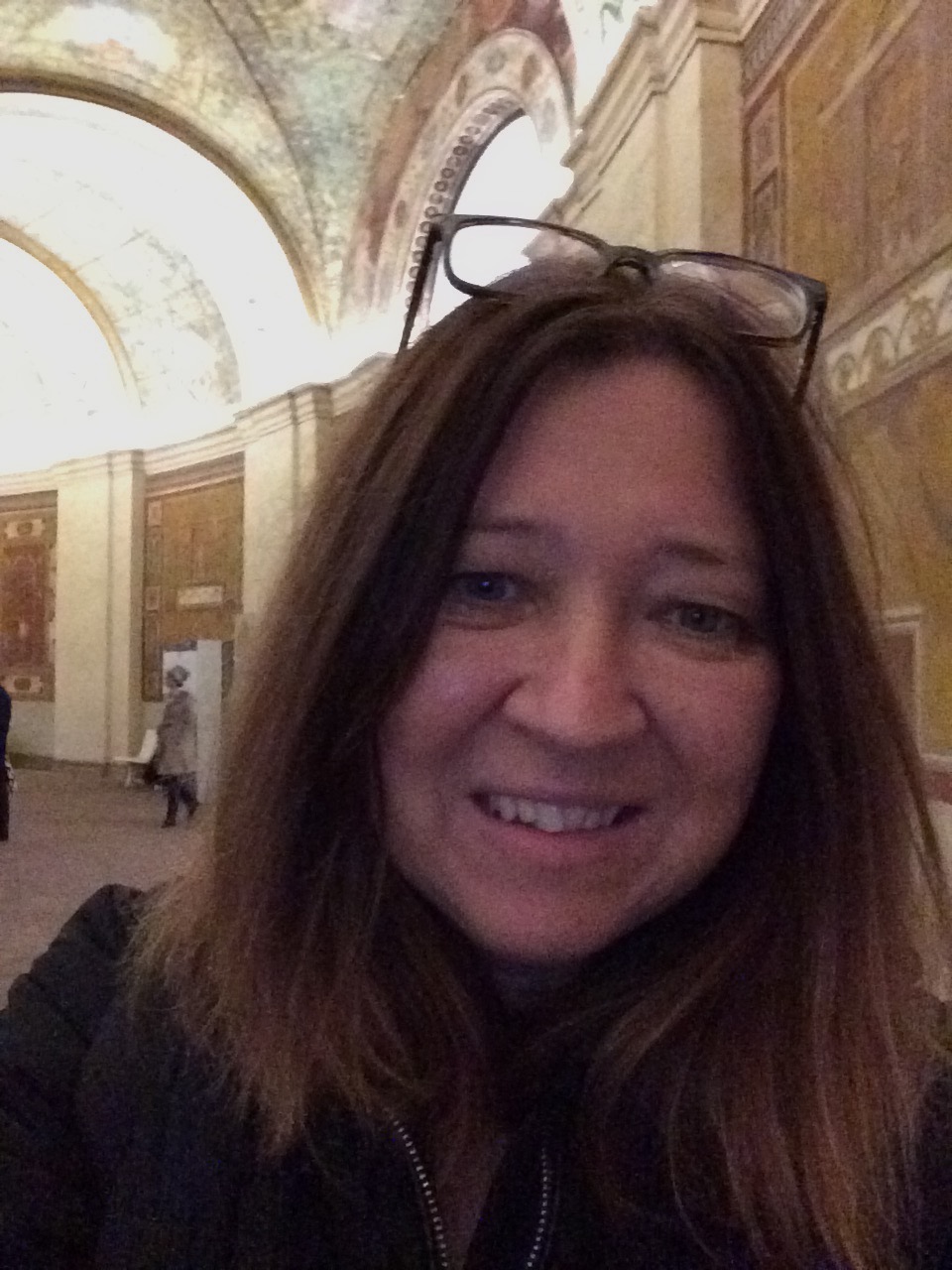“Situated Solidarity”: A New Curatorial Model for the European Nomadic Biennial?
The fourteenth edition of the nomadic European biennial Manifesta took place in Prishtina, Kosovo, from July 22 to October 30, 2022. The biennial included 25 exhibition venues in an urban parcours throughout the city, ranging from (dilapidated) historic monuments and institutions to public squares, abandoned buildings, and unused or unexpected urban spaces. Four of these venues have been declared “major pillars,” namely the Grand Hotel Prishtina, The Center for Narrative Practices (a former library), an abandoned brick factory on the outskirts of the city, and the so-called Green Corridor, an unused train track that has been transformed into a walking trail. A total of 103 artists, artist collectives and cultural practitioners participated in this Manifesta, 64% of whom were from Kosovo and the Western Balkans, and 45% of them presented new or specifically adapted works for the context of Prishtina. The director of Manifesta stated that Manifesta 14 Prishtina has developed a new model for the Biennial, marking a new moment in its more than 25-year history. Since the venues and artistic context of Manifesta 14 Prishtina have already been discussed extensively in the press, this article explores how this seemingly quite productive new Manifesta model can be understood through, and intersects with, the topic of this special issue of ARTMargins Online: solidarity.
Fragments 1 – Where Stories cut across the Land (2015-2018) is a video installation at Manifesta 14 Prishtina by Albanian artist Vangjush Vellahu, featuring six documentary videos about unrecognized or semi-recognized countries with disputed borders, including Kosovo. The monitors were scattered on the third floor of the Grand Hotel Prishtina in front of the elevators. The run-down and dilapidated but iconic hotel, designed in 1978 to house former Yugoslav president Josip Broz Tito, was chosen as the central exhibition venue for this year’s Manifesta. As Vellahu’s camera films Kosovo from a bird’s eye view, a voice-over from a local citizen tells how difficult it is to tear down different kinds of walls: physical walls (Kosovar Albanians still brick their courtyards, wary of returning Serbs), psychological walls (between Albanians and Serbs, because of the tensions that persisted after the Kosovo War), and political walls (not only with Serbia, but also with the European Union). Free, but traumatized by war and confined to their territory by a strict visa regime, Kosovo’s citizens live between freedom and unfreedom; or in “a hybrid form, somewhere between freedom and captivity.”(Witold Szabloswki, Dancing Bears, Nostalgia for Communism (Amsterdam, Nieuw Amsterdam, 2019), p. 102. Szabloswki uses this phrase in the very different context of rescued, caged and mistreated bears struggling to adapt to the new situation of relative freedom in a bear sanctuary in the post-Communist era. He describes the reserve as a “laboratory for freedom research” (p.14) but, importantly for my argument here, uses it as a metaphor for the transitional barriers to freedom of citizens of post-socialist states.)

Vangjush Vellahu, Fragments 1 – Where Stories cut across the Land (2015-2018), Image courtesy of Manifesta 14 Prishtina. Photograph by Majlinda Hoxha. All photos are by courtesy of Manifesta 14 Prishtina, unless otherwise indicated.
At the press conference, Manifesta director Hedwig Fijen made it clear that something is politically at stake this year: “awareness” of Kosovo’s isolation due to visa rules and the need to “connect Kosovo to the rest of the world.”(Hedwig Fijen, Press conference at the opening of Manifesta 14, Grand Hotel Prishtina, July 21, 2022.) She added that the EU is “not very hospitable to Kosovars,” as evidenced by its failure to implement long promised visa liberalization.(Ibid. Kosovo began the visa liberalization process for free travel within the EU in 2012. It has met all visa-free travel requirements since 2018, but has been consistently rejected by several states (France, Spain and, to my embarrassment, my own country, the Netherlands), including some that do not recognize its sovereignty. At the time of this press conference, on July 21, 2022, it was not yet clear that on November 22, 2022, shortly after the close of Manifesta, the EU had finally reached an agreement on visa liberalization for Kosovo.) Balkan historian Erich Rathfelder explains how the situation of “limited sovereignty” and “half freedom” came about: it is a result of the conflict between Serbia and Kosovo culminating in the Kosovo War (1998-1999), when Kosovo was fighting for secession from Serbia and the regime of a particularly aggressive Slobodan Milošević, bent upon his nationalist dream of a Greater Serbia. As things deteriorated, NATO intervened, and in the negotiations to end the war, Kosovo came under the supervision of various international and EU bodies. These were created to protect an independent Kosovo, but without wanting to put too much strain on Serbia, in order to to prevent a new conflict from flaring up. This leads Rathfelder to ask a sharp critical question that still seems relevant today: “War also die Unabhängigkeit nicht anderes als eine Schimäre?”(Erich Rathfelder, Kosovo: Geschichte eines Konflikts (Berlin: Suhrkamp, 2010), p. 404. This dual approach, Rathfelder argues, keeps Kosovo dependent on foreign aid. This runs counter to the EU’s commitment not only to a politically independent country, but also to its economic independence and growth – which is only possible with free movement and access to the European market. Ironically, Kosovars had more freedom of movement when Kosovo was still part of Yugoslavia (including to the west).)
No wonder Fijen, who wanted Manifesta to open up and empower Kosovo, stressed that “we need to address these issues.”(Fijen, Press conference.) Thus, Manifesta’s press kit included a call to action: “Art and culture carry the power of change (…) the recognition of Kosovo’s isolation calls for solidarity from peers in the international arts and cultural spheres, and beyond.”(International Foundation Manifesta, “A Call for Action”, Press Kit Manifesta (2022).) Solidarity is clearly a central concept of this Manifesta, which makes it interesting to analyze how it manifests in art for this special issue of ARTMargins Online. Solidarity, of course, is a broad and multifaceted concept, with a complex social and political history around the world, and therefore the term cannot be used without qualifying it. In recent decades, the concept of solidarity has gained importance in the arts at least since Claire Bishop signaled a “social turn” in contemporary art (2004).(Claire Bishop, “The Social Turn: Collaboration and its Discontents,” Artforum (February 2006): pp. 178-183.) However, the editors of the recently published Art and Solidarity Reader (2022) note that “solidarity is one of the most evoked but least analyzed concepts within the arts.” Therefore, they continue, it is at once “a powerful idea and a slippery category.”(Katya Garcia-Anton, “Introduction. On the Possibilities of Art and Solidarity to Restructure Relations and Make Worlds,” in Art and Solidarity Reader: Radical Actions, Politics and Friendships (Amsterdam: Valiz, 2022), p. 8.) Given the complexity of the concept of solidarity, I focus on Manifesta 14 because this exhibition offers a very concrete and effective translation of the concept of solidarity into a model for artistic and curatorial practice. The question is: how does Manifesta venture beyond solidarity as a powerful yet vague zeitgeist and make it operable and sustainable? What makes Manifesta different from other exhibitions where the notion of solidarity or the related concept of collectivity are an integral part of the exhibition concept, particularly this year’s documenta fifteen, which became entangled in a seemingly endless wrangling over accusations of anti-Semitism, turning solidarity and collectivity into political polarization that led to questionable censorship?(The events surrounding Documenta can be followed in quality German newspapers, such as the Frankfurter Algemeine and the Süddeutsche Zeitung, and in the international art press. For my review of Documenta, co-authored with Max Bruinsma, see “Rumble in the ruruHouse – on documenta fifteen and ruangrupa’s global art movement,” Metropolis M, 13 July 2022, https://www.metropolism.com/en/reviews/47262.)
Situated Solidarity
Manifesta 14 has indeed changed its curatorial model, as Fijen confirms in the publication Public After All (2022): “We transformed Manifesta and changed the organization into an interdisciplinary knowledge- and research-producing platform, focused on participatory practices with local communities. This makes the Biennial more responsive to local interests, needs and urgencies.”(Hedwig Fijen, “Manifesta 14, Prishtina. Who Owns the City,” in Public After All, edited by Carlo Ratti Associati (Prishtina: Illiri Print, 2022), p. 27.) The hypothesis I propose here is that Manifesta’s new model of cultural research as pioneered in Prishtina is related to (and can be understood through) a concept of solidarity known in academic research as “situated solidarity.” This concept was introduced in 2007 by Richa Nagar and Susan Geiger in their search for how fieldwork on feminist and gender issues could be conducted across borders and multiple divisions (social class, ethnicity, gender) around the world, without simply projecting the interests of “the privileged,” i.e. white, Western attitudes, ideas, and perceptions.(Richa Nagar and Susan Geiger, “Reflexivity and Positionality in Feminist Fieldwork Revisited,” in Politics and Practice in Economic Geography, ed. by Adam Tickell et.al (London: Sage Publications, 2007). Nagar has further developed ideas on solidarity and related terms in Richa Nagar, Muddying the Waters: Coauthoring Feminisms across Scholarship and Activism (Champaign: University of Illinois Press, 2014).) Nagar and Geiger argue that the researcher’s awareness of their own identity and perspective (defined by the terms “reflectivity” and “positionality”) is not enough for “progressive research” that wants to engage in “the material politics of social change.”(Nagar and Geiger, “Feminist Fieldwork Revisited,” n.p.) To clarify their approach, which is focused on historical, political, social, economic, and institutional forces that shape local culture, they describe situated solidarity as “attentive to the ways in which our ability to evoke the global in relation to the local and to participate in processes of social change are significantly shaped by our geographical and socio-institutional locations, and the particular combination of processes, events, struggles underway in those locations.”(Ibid.) At the core of this bottom-up approach is a participatory model that is critical of the long tradition of “participatory observation” in cultural anthropology and sociology, in which researchers study culture through a “speaking-with model,” but do not engage in social change processes together with those studied.(Ibid.)
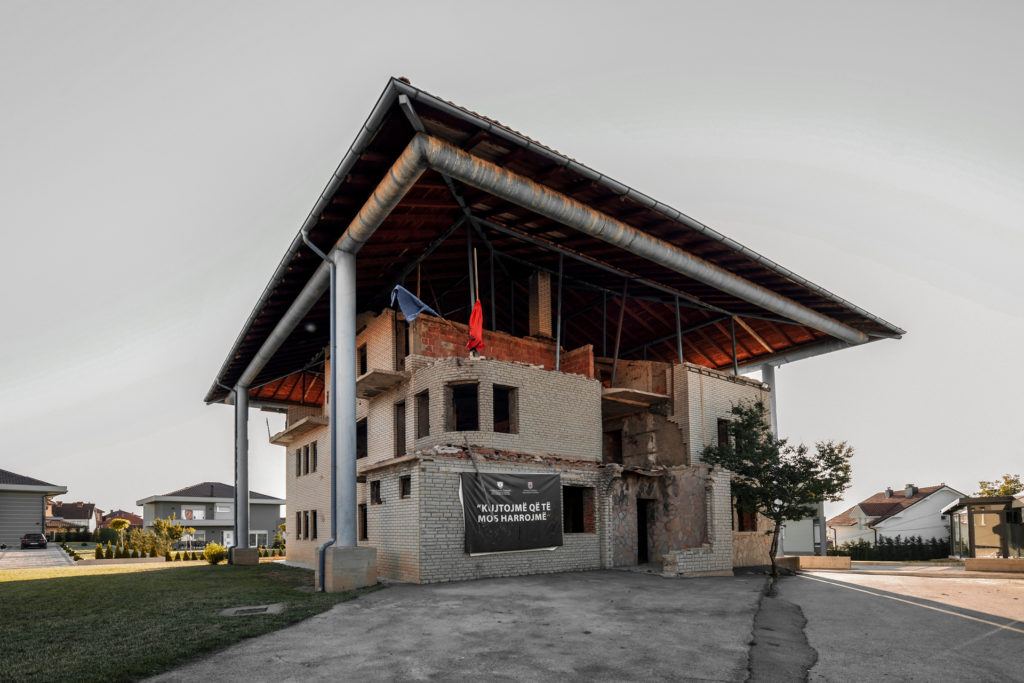
ETEA, School without School (2022). Photograph by Majlinda Hoxha.
To be relevant for a cultural event like Manifesta, the concept of situated solidarity should be expanded to the realm of arts and culture. I argue that if the concept is indeed broadened to include the artistic research and cultural engagement that Manifesta demonstrates in relation to the state of affairs in Kosovo and the Western Balkans, the Biennial might be understood as a kind of field research that “nestles” in another culture in order to explore and better understand it and to foster cultural change or to have a political impact. Manifesta’s attention to local culture is evident in the “radically local approach” to the selection of artworks, 64% of which were by artists from the Western Balkans, including 39% by Kosovar artists.(Facts provided by Manifesta Foundation, “Manifesta 14 Prishtina in Short,” status update September 28, 2022.) And other typical features of situated solidarity, such as “collective knowledge production” and “attention to local priorities” (e.g. lobbying for visa liberalization to break Kosovars’ isolation), play a decisive role in this Manifesta.

ETEA, School without School (2022).
Photograph by Majlinda Hoxha.
A paragon of situated solidarity is the exhibition at a smaller Manifesta venue on the outskirts of the city, featuring a series of documentaries entitled School without School (2022), in a former private home that housed the underground Hertica school (named after its owner, Mehmet Aliu-Hertica) before the Kosovo War in the 1990s. Commissioned by ETEA, a Kosovar NGO whose work includes cultural heritage education, a temporary roof was erected over this bombed-out building on the outskirts of Prishtina, while inside, in the dilapidated classrooms, the documentary videos provide insight into the history of the school where Kosovar Albanian teachers illegally taught hundreds of students to keep Albanian education alive during Serbian repression. In one of the documentaries, teacher Shyqëri Obërtinca holds that the Serbs had detailed plans to systematically destroy Albanian education in Kosovo, which was not limited to banning the Albanian language and increasingly strict segregation policies, but also included poisoning children.
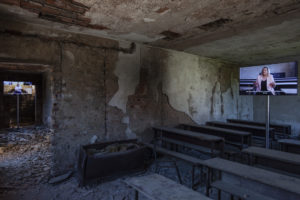
ETEA, School without School (2022). Photograph by Majlinda Hoxha.
In another video, then Catholic priest Dodë Gjergji tells how he opened his church to the victims of the Serbian regime and turned it into a hospital where nurses and medicine were smuggled in. Both priest and teacher report on the unprecedented solidarity at the time. The priest, visibly emotional, recounts how a grandfather trusted that his badly injured niece was in good hands with him, even though the old man was not allowed to see her because of her condition. The teacher recalls how “the solidarity of Kosovo Albanians amazed not only Europeans but also the world.”(Documentary video School without a School (2022), report by Shyqëri Obërtinca.) The documentaries together tell Hertica School’s story and educate visitors about the power of solidarity, which the priest says has faded today. My point here is that Manifesta is taking the situated solidarity approach by first researching the historical, political and institutional context of the school in collaboration with the Kosovo NGO and then, based on that, helping to realize the videos (with financial support) and participating in ETEA’s long-term goal of preserving this house as a “situated” site of cultural heritage.(This project was designed specifically for Manifesta 14. ETEA applied through an open call by Manifesta in 2021 and they were one of 13 NGOs chosen to carry out their project. It is expected that the Hertica School’s cultural and educational heritage will be preserved for the future, although a concrete plan is as yet absent.)
Public Space and Other Narratives
Manifesta 14’s curatorial team consisted of two so-called “creative mediators,” a term Manifesta prefers to curators because it suggests dialogue and less authority than the conventional term. One is the Berlin-based Australian curator and scholar Catherine Nichols, known for exhibitions in art institutions across Germany, who often embraces collaborative and transdisciplinary practices, and the other is the Italian design firm CRA-Carlo Ratti Associati, known for its approach to open-source architecture and participatory urbanism.(For more information on the backgrounds and projects of these creative mediators, see: https://carloratti.com/ and https://myartguides.com/people/catherine-nichols/.) Making public underexposed “stories”—such as the harrowing oppression in Kosovo in the 1990s—fits well with Nichols’ program to bring other stories to light.(In quotes because de facto, of course, they are not stories but historical facts, or conveyed historical facts. The term story is somewhat misleading because in everyday language it refers to fiction rather than facts.) Nichols’ curatorial theme, “it matters what worlds world worlds: how to tell stories otherwise” is a direct reference to Donna Haraway’s idea that dominant narratives and the power relations they perpetuate can be subverted or overcome by telling stories differently, making other worlds possible. Stories told otherwise, in other words, have transformative power. In Haraway’s words: “Who owns life stories and who has access to another’s story are crucial questions in struggles for the sovereignty (…).”(Donna Haraway, “It Matters What Stories Tell Stories; It Matters Whose Stories Tell Stories,” Auto/biography Studies (2019): p. 4. DOI 10.1080/08989575.2019.1664.163. The focus of Haraway’s article is different from Manifesta’s: the survival of species in the Anthropocene and the Capitalocene, using biological metaphors.)[21] For Nichols, the dominant narratives to be subverted are those “based on human exceptionalism, nationalist ideologies and capitalist triumphalism.”(Catherine Nichols, Guide Book Manifesta 14 (Prishtina, 2022), p. 44.) In the context of Manifesta, it is tempting to interpret the idea specifically as an attack on the Serbian nationalist narrative of Kosovo’s central role in Serbia’s founding myth, which in turn causes Serbia to deny Kosovo’s sovereignty. However, Nichols envisions a more nuanced transformative force, namely stories developed by ordinary people to process their pasts and build a hopeful future. This ties in with Haraway’s phrase “rich pasts to sustain thick presents (…) for those who come after (…),” which helped Nichols to account for Kosovo’s multiethnic complexity, with Bosnians, Gorani, Roma, Turks, and Serbs living alongside the Albanians.(Ibid., p. 44.)
In addition to Haraway’s concept of storytelling as a curatorial organizing principle, Hannah Arendt’s idea of the “space of appearance” is used as an implied theoretical framework.(I use the term “implied” here because Nichols explained in my conversation with her that she does not want to “overburden Manifesta with theory.” She affirmed, however, that Arendt has been important to her as a philosophical framework for thinking about public space. Nichols, conversation with the author.) Arendt succinctly describes this concept in The Human Condition (1958) as the space “where I appear to others as others appear to me.”(Hannah Arendt, The Human Condition (Chicago: The University of Chicago Press, 1958), p. 198.) Her definition of public space is essentially a potential space, a space that is always everywhere in the bud, but must be constantly (re-)created, or in the political philosopher’s words, “Wherever people gather, it is potentially there, but only in potentiality, not necessarily and not forever.”(Ibid., p. 199.) Such a notion of possible, evolving public space is particularly useful in a country still scarred by war and where public space is difficult to create because of rampant capitalism and private interests. Arendt’s specific concept of, and approach to, human-centered public space was important to Nichols in conceptualizing Manifesta’s artistic program because she sees it as “a prerequisite for critical engagement.”(Nichols, conversation with the author.)
Arendt’s participatory idea of public space that only needs to be activated by people also links Nichols’ curatorial approach to ideas of “Reclaiming public space” of CRA, who were responsible for developing an urban vision for Prishtina. In the years leading up to Manifesta, this office, led by Carlo Ratti, conducted extensive field research that can be qualified as a situated solidarity approach. The main outcome of CRA’s research, based on listening and talking to local citizens, experts, and communities (identified here as “the speaking-with” model), was the widely expressed desire to restore public spaces. In Ratti’s words, “All the people we talked to undeniably loved Prishtina (…) and still decried the state of public space.”(Ratti Associati, Public After All, p. 45. Public After All (2022) provides a detailed account of the various steps of CRA’s vision for Prishtina, along with data that emerged from the research, illustrated with diagrams, statistics, maps, digital imagery and photos. The research maps the types of spaces that could potentially be transformed into public spaces – not only the obvious monuments and cultural institutions, but also nondescript spaces such as unofficial parking lots, spaces that served primarily as garbage dumps, or quasi-green lawns that never became public-friendly parks. In conducting research, the team used the latest digital tools for geomapping, such as AI methods to track and analyze how public space is being used in real time (in collaboration with MIT’s Senseable City Lab), in addition to Google-like street mapping (with students from the University of Prishtina).) This unequivocal result triggered the idea of turning “reclaiming public space” into the starting point of the CRA’s urban vision, intelligently translated as “Commons Sense.” Conducted methodologically through participatory urbanism, the project is also modeled on Eric Klinenberg’s idea of “social infrastructure,” which lays bare the relationship between the urban environment and the social sphere. In the sociologist’s words, “the built environment influences the breadth and depth of our associations.”(Ibid., p. 151.) CRA’s urban approach echoes Klinenberg’s “breadth and depth,” as it ranged from simply reclaiming public space by demarcating unused (The Green Corridor, for example, an appropriated train track) or abandoned spaces (such as a former Brick Factory) with a pot of yellow paint (Ratti’s signature color for Manifesta 14) to designing Corbusian grandiose plans for a pedestrian bridge over an arterial road to connect two pompous Yugoslav-era buildings. The repurposing tactic of yellow lines was used liberally to reclaim sites in the city, but the bridge remains a visionary plan. In all, by combining the approaches of the creative mediators, Manifesta sought nothing less than to recapture and revitalize Prishtina’s public spaces through artistic projects and urban interventions in relation to its (often damaged, abandoned or poorly exploited) cultural heritage and urban infrastructure. Manifesta’s overarching goal—forging solidarity with Kosovo through art and culture—is firmly situated and solidified in the built environment. Still, the question remains to what extent this goal has been achieved and what critical questions can be raised when the event even gets the attention of the most neoliberal of all magazines, The Economist, which reported that “Manifesta 14 invigorates neglected spaces in Kosovo’s capital” and is “trying to help its host city in the long term.”(See https://www.economist.com/culture/2022/07/29/manifesta-14-reinvigorates-neglected-spaces-in-kosovos-capital, accessed July 29, 2022.)
Scarred Monuments and Institutions
Before answering this question, however, it is important to explain how situated solidarity is put into practice in actual artworks and exhibition spaces. This embedded form of solidarity after all, established and expressed through distinctly situated art, characterizes almost all Manifesta venues, whether small (e.g., The Hertica School) or large (e.g. Grand Hotel Prishtina). For lack of space to show how the concept of situated solidarity is mobilized to connect and traverse all the buildings and attendant exhibition spaces, I will limit myself to two key venues, Grand Hotel Prishtina and the former Hivzi Sulejmani Library, renamed by Manifesta as The Center for Narrative Practice.
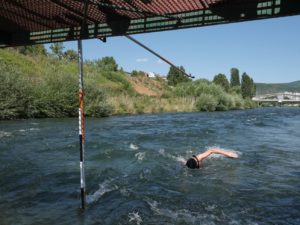
Pierre Greville, What is Here (2022). Image courtesy of Pierre Greville. Photograph by Marcello Maranzan.
The Grand Hotel Prishtina hosted Manifesta’s largest exhibition, curated by Nichols and titled “The Grand Scheme of Things.” Wandering through its decrepit rooms, corridors and floors, which were cleared from rubble and made publicly accessible by Manifesta’s budget for urban projects,(Of the total budget of circa €5 million, €764,000 was used for urban projects such as the cleanup, restoration and refurbishment of the former Hivzi Sulejmani Library, the Brick Factory, the Green Corridor, and the public accessibility of the Grand Hotel Prishtina. Source: Manifesta Foundation, “Manifesta 14 Prishtina in Short,” Status September 28, 2022.) visitors gradually gained more knowledge and understanding of the once illustrious hotel through artworks responding to the building, its history and context. Most of the artworks received extensive press coverage, but I will mention a few to give an idea of how the building comes to life and how the idea of situated solidarity is “put to work” in the art. Kosovar photographer Majlinda Hoxha tracked down the lost and sold artworks that once adorned the luxury hotel and installed her photographs of these works where they originally hung. Young Kosovar artists created postmodern paintings for the atrium of Tito’s wing, replacing the equally defunct earlier paintings. In How Ideology Moved our Collective Body (2013), Serbian artist Marta Popivoda revisits and questions the ideology of solidarity as it played out under socialism, using documentary film and video footage. Genti Korini’s Spider’s Envy (2022) contrasted a video showing a debate between an authoritative Albanian socialist art critic and a modernist-inspired artist with annotated archival footage of court cases against artists. The project offers insight into the tension between abstract modernism and socialist realism, and how Albanian artists could be persecuted if they chose the former over the latter. The relationship between Kosovo Albanians and Serbs is the subject of What Is Here (2022) by Australian artist Pierre Greville, as part of Kosovo-born curator Petrit Abazi’s exhibition Unbordering Worlds in Mitrovica, northern Kosovo. In this divided town, where Serbs live on one side of the river and Albanians on the other, the artist invited boys from both sides to swim against the current under a bridge that is rarely used—an act of situated solidarity to overcome the unresolved conflict together. This in situ project could also be viewed remotely via a video stream in Grand Hotel Prishtina.
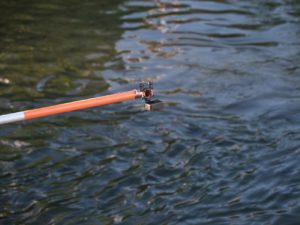
Pierre Greville, What is Here (2022). Image courtesy of Pierre Greville. Photograph by Marcello Maranzan.
It is not that the entire hotel was filled with art that responded to the building, its history, and the underlying socialist ideology; that would make the curatorial concept far too rigid and prescriptive. A wide variety of artworks and other creative projects were brought together with a specific theme for each of the seven floors that Kosovars had identified as important during the research phase (transition, migration, water, capital, love, ecology, and speculation, respectively). The themes were thus particularly relevant to artists from Kosovo and the Western Balkans, but broad enough to create a dialogue with the work of the invited international artists. All in all, solidarity at the Grand Hotel Prishtina was put into artistic and curatorial practice in different ways and on multiple levels. First, in the “speaking-with model of engagement”(Nagar and Geiger, “Feminist Fieldwork Revisited,” n.p.) between the creative mediator (Nichols) and local citizens and groups who co-decided on the relevant issues. But also by emphasizing the importance of the site, and the history and ideology in which it is embedded—to which many artworks have responded and reflected, creating collective knowledge about the place and its context.
A key objective of situated solidarity is to create connections between the local and the global, achieved in Manifesta through dialogue between local and international artworks based on themes with both unquestionable local relevance and international resonance. Furthermore, situated solidarity encourages an active approach to the visiting public, who not only enjoy the artwork as they ‘tour’ the hotel, but are also educated about this building in its historical, political, and ideological context, trying “to plot pieces of the puzzle into a coherent picture,” as critic Cathryn Drake put it.(Cathryn Drake, “Manifesta-14,“ Art Agenda, July 29, 2022, https://www.art-agenda.com/criticism/481952/ manifesta-14-it-matters-what-worlds-world-worlds-how-to-tell-stories-otherwise/.) This art-generated knowledge production fosters a deeper understanding of Kosovo’s “rich pasts and thick presents” (Haraway), which can be seen as a prerequisite for the ultimate goal of (Manifesta’s) situated solidarity to engage with social processes and bring about cultural change. On the roof of the hotel, Kosovo-born artist Petrit Halilaj showed a direction for a vision of solidarity and hope for the country’s future (“for those who come after”) through an imaginative recreation of the six stars (representing Kosovo’s ethnic groups) that adorned the hotel, to which he added his own optimistic, poetic message in the original neon light: “When the sun goes away we paint the sky.”
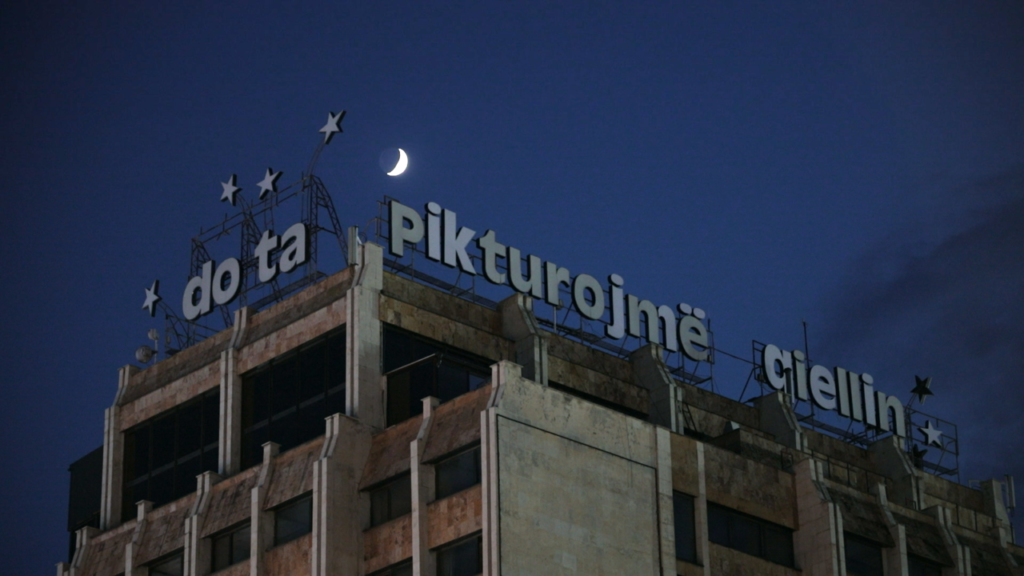
Petrit Halilaj, When the Sun goes away, we paint the Sky (2022). Photograph by Hana Agimi, YII Çitaku.
An implicit premise of the situated solidarity approach, as defined by Nagar and Geiger, is a long-term commitment to the site of research. As they put it in a question: “how can the production of knowledges be tied explicitly to a material politics of social change favoring less privileged communities and places?”(Nagar and Geiger, “Feminist Fieldwork Revisited,” n.p.) And that is exactly what the Manifesta team, which operationalized situated solidarity with art and culture, is aiming for in Prishtina, as it seems to agree with the feminist researchers that in the arts as well, “limited engagement has foreclosed opportunities.”(Ibid.) This commitment is best exemplified by another major Manifesta venue—one where solidarity takes on a distinctly material and (transformative) institutional form, namely The Center for Narrative Practice, or the former Hivzi Sulejmani Library. For years the historic villa was an abandoned building, in a courtyard hidden from view in Prishtina’s city center. The area was first reclaimed with CRA’s yellow paint and urban furniture, and then completely renovated so that—with decisive input from local residents—it could undergo a true metamorphosis with a redesigned garden and a new café. The building’s function was expanded from a regular public library to a free-access, interdisciplinary cultural and educational institution with project, work and studio spaces and an expanded library.
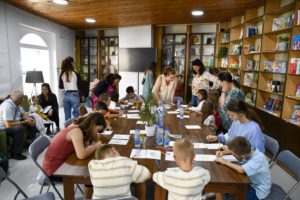
Manifesta 14, The Center for Narrative Practice, Drawing Workshop and Story Lab, Photograph by Atdhe Mulla.
The name of this new institute, The Center for Narrative Practice, aligns closely with the theme of Manifesta 14, and throughout the 100 days of Manifesta 14 (until 30 October 2022), there was a program focused on “other stories” through collaborative workshops, performances, radio broadcasts and art. The center housed The Academy of Others, conceived by Valentina Bonizzi, which “explores storytelling, storytellers and selfhood.”(Valentina Bonizzi, Academy of Others (2022). Besa Luci’s contribution to the academy discussed here was edited by Bonizzi in collaboration with Luci. Lucy’s story is told by a voice-over accompanying the drawings.) Against the backdrop of animated drawings, one of the narrators, Besa Luci, chief editor of Kosovo 2.0, a contemporary print and online journal that began in the 1990s as a Blogger platform, tells why and under what circumstances her journey into alternative forms of journalism and storytelling came about around the Kosovo War. She explains how she switched from a journalism that truthfully tells the facts to the human stories behind the raw information, especially of people who are too little heard, such as the long-suppressed stories and experiences of Kosovar Albanians like herself. In a conventional art context, Luci’s pre-recorded, animated narrative could be criticized as an attempt at self-promotion, but here it functions more as an autobiographical story of healing collective interest, consciously shaped in an audience-friendly, cultural form.
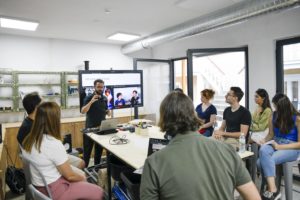
Manifesta 14, The Center for Narrative Practice, Drawing Workshop and Story Lab, Photograph by Atdhe Mulla.
Most importantly, in terms of realized long-term goals, Manifesta secured a four-year contract and budget for the Center of Narrative practice, funded by a few EU member states and international networks, besides the municipality of Prishtina.(The Grand Duchy of Luxembourg, the Royal Embassy of the Netherlands in Kosovo and the United Nations Development Programme. Source: Manifesta, “The Legacy of Manifesta 14 Prishtina (2022).”) In short, the center is a concrete example of how solidarity is consolidated in a physical building and site. So, Manifesta practices what it preaches by seeking a lasting impact on their host city and backing up their ambition with considerable financial resources.(764,000 euros for urban projects, including the refurbishment of the Hivzi Sulejmani library (see note 30).) This effort is to ensure that the Manifesta has a long-term effect—essential to a situated solidarity approach—not only in an intangible sense (by putting Kosovo’s art in the spotlights and connecting it to global art), but also in a more material sense of an expanded cultural infrastructure in Pristina. To varying degrees, this is also true of Manifesta’s other so-called “main pillars,” such as The Brick Factory and The Green Corridor.(The abandoned brick factory, for example, was revitalized into an eco-urban learning center by Raum Labor Berlin during Manifesta 14’s “100 days.” The Municipality of Pristina has pledged to invest additional funds to further develop the site starting in 2023, possibly leading to a coveted future contemporary art museum.)
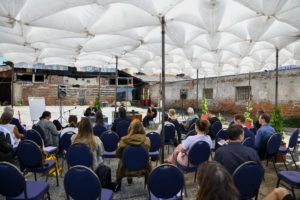
Manifesta 14, Workshop at Brick Factory (2022). Photograph by Atdhe Mulla.
It should be clear by now that situated solidarity manifests itself at Manifesta 14 Prishtina on multiple material and immaterial levels. One intangible level, which is hardly discussed in the press, is the opening of new narratives and perspectives for art history. A pioneering exhibition in Kosovo’s contemporary art history was reconstructed in another small Manifesta venue, project space Foundation 17. Using some of the original artworks and archival sources, and with a guided tour for those who wished, it evoked the exhibition Përtej, with artworks by four then-young Kosovar Albanian avant-garde artists and a composer. Përtej was organized in 1997 at the Center for Cultural Decontamination in the Serbian capital Belgrade—in the lion’s den, that is, just before the outbreak of the Kosovo War. Curator Shkëlzen Maliqi wanted to take Kosovar art beyond the country’s borders (Përtej means “beyond”): “Is the emergence of the generation of young and ‘angry’ Kosovo artists only a shock of local importance? Or can they, as authentic destroyers of convention, establish wider communication with modern artistic trends in the world?”(See, among others, Shkëlzen Maliqi’s personal site at https://shkelzenmaliqi.wordpress.com/1997/06/01/.)
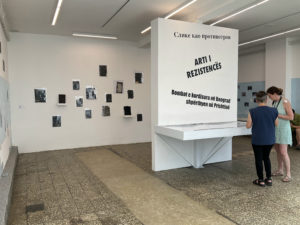
Foundation 17, Përtej – Archiving Transition (2022). Photograph by the author.
This was controversial at the time, because it concerned resistance art from Kosovo in Serbia, and the art on display was an unequivocal artistic response to Serbian oppression, with works such as Sokol Beqiri’s “ethnobomb,” Mehmet Behluli’s blackened painted reliefs, and the electro-acoustic sounds produced by Ilir Bajri to give his music the same atmosphere as in the artworks. As Behluli summed it up, “Through art, we expressed our revolt.”(Mehmet Behluli, Përtej – Archiving Transition, Grand Hotel Prishtina (2022).) This exhibition is further explored in a kind of retrospective installation at the Grand Hotel Prishtina, where the curator and three of the artists reflect on their historic exhibition in documentary interviews. Eastern and Central European art gradually conquered its well-deserved place on the art historical map after 1989, as evidenced by books from Irwin’s East Art Map (2004) to MoMA’s anthology Art and Theory of Post 1989 (2018), but the relatively underexposed art from Kosovo and the Western Balkans, or Southeastern Europe, certainly adds a dynamic new chapter.
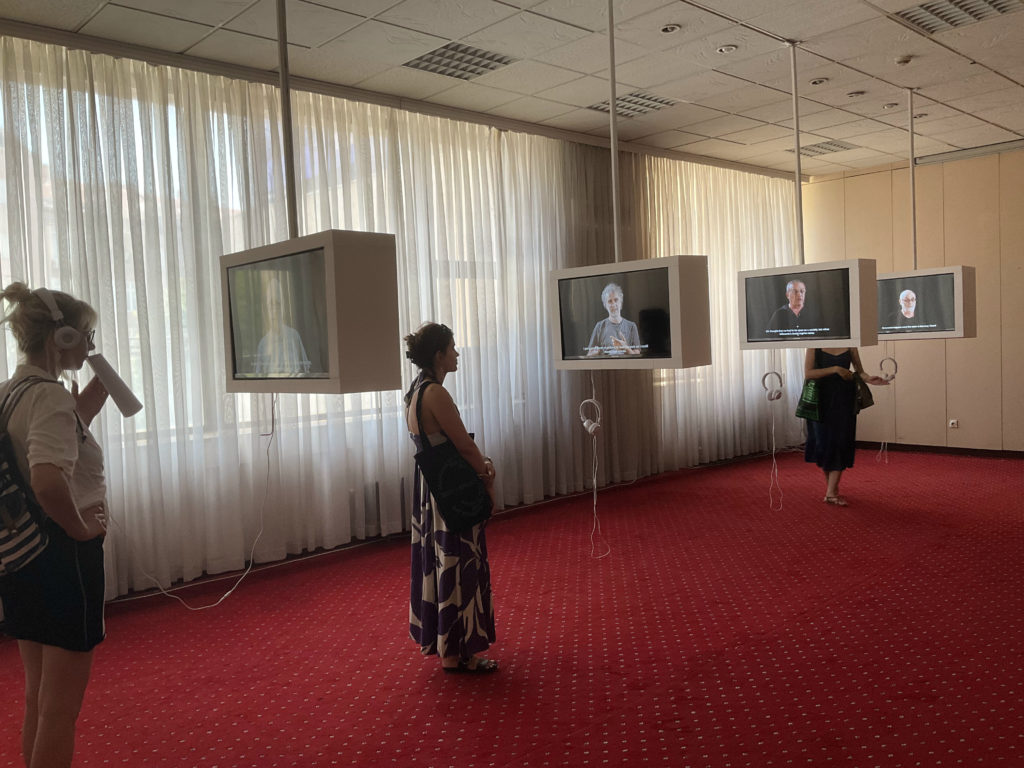
Foundation 17, Përtej – Archiving Transition (2022). Photograph by the author.
Manifesta’s New Curatorial Model
The premise of solidarity in the program and content of Manifesta goes far beyond the rhetoric of “togetherness” and collectivity en vogue in art, and is expressed on a much deeper and layered level in the politics, culture, and (art) history of the Western Balkans, Kosovo in particular. Situated solidarity involves reconsidering the concept of solidarity and what it can mean when it is not only situated but also consolidated in the place of inquiry. The term solidarity is usually interpreted as the idea (or ideal) that we are stronger together. The etymological basis lies in the word “sol,” which refers to the notion of “whole.” However, there is another etymological source of solidarity, namely the Latin “solidus” in the sense of “solid or firm” or even “material solidity” (not fluid). In the context of art discourse, we could speak of a rooted solidarity—an in situ or site-specific solidarity that indeed solidifies into new cultural infrastructure and long-term commitments. Manifesta 14 took up this challenge by developing an approach that invokes both meanings of the term solidarity. This two-fold interpretation distinguishes Manifesta 14 from other exhibitions that ride on the zeitgeist of solidarity, such as documenta fifteen in Kassel. The curatorial principles of documenta fifteen resembled those of Manifesta 14 in that they both built on ideas of collectivity, participation and, indeed, solidarity. But documenta was heavily criticized for alleged anti-Semitic tropes, while Manifesta received praise for its engagement with Kosovo. documenta’s approach was to invite almost exclusively artist collectives from around the world, turning global solidarity into the main curatorial principle. Unlike Manifesta, it was not “radically local,” but all too radically global and too removed from, or insensitive to, the host city of Kassel and Germany’s complex (post-)war history. Collective and participatory approaches in Manifesta are intricately linked to local concerns and political struggles—characteristic of a situated solidarity approach. They share a more grounded or situated common purpose that provides a more modest and operable “we-ideal,” to use Helmut Draxler’s term, than the more vague, universal, but ultimately contentious, “we” underlying documenta fifteen.(Helmut Draxler, “The We-Ideal. Toward a Critique of Collectivity,” Texte zur Kunst 124 (2021): pp. 43-65.)
Manifesta 14 has developed the situated solidarity approach, as I have argued, into a new curatorial model. This approach has been prepared in previous editions, such as Manifesta 12 (Palermo) and Manifesta 13 (Marseille), which used collaborative and participatory practices and a knowledge- and research-based approach. On the other hand, not everything has changed in the “Prishtina model.”(CRA-Carlo Ratti Associati, “Reclaiming Public Space through Open-Source Urbanism,” in Public After All (2022), p. 65. CRA suggests to identify the innovative urban approach at Manifesta 14 as the Pristhina Model.) Many of the basic principles and ideological frameworks that were established in the first years of Manifesta still apply today.(For a critical discussion of Manifesta’s principles as defined in its early years, see Camiel van Winkel, “The Rhetoric of Manifesta,” in The Manifesta Decade, edited by Barbera Vanderlinden and Elena Filipovic (Cambridge, Mass.: MIT Press, 2005), p. 219.) Manifesta is essentially based on the democratic idea of an open society that also characterized the Soros Centers for Contemporary Art (SCCA).(For the links between Manifesta, the Soros Centers for Contemporary art and ‘the open society idea, see Hedwig Fijen, et. al, “How a European Biennial of Contemporary Art Began,” in The Manifesta Decade, p. 195.) As Octavian Eşanu has shown, there are some problems with this ideology, especially when exported from the Western-European capitalist world to post-conflict countries. Already twenty years ago, Eşanu suggested a new field of study that critically examines “transitology.”(Octavian Eşanu, “‘During’: The Transition to Capitalism,” in Art and Theory of Post-1989: Central and Eastern European Art, edited by Ana Janevski, Roxana Marcoci, and Ksenia Nouril (New York: MoMA, 2018), p. 99.) The question is whether Manifesta 14—which thrives on the theme of transition—will not continue this trend: nestling in a marginalized country in the Western Balkans, with largely Western European and international investments and other neoliberal stakes (The Economist’s aforementioned interest might ring alarm bells), not to mention the promotion of Western notions of democracy, openness, and diversity, which are under attack, even in European Union member states. Stories told otherwise are never neutral, of course, but politically and ideologically as invested as those to be modified or replaced. In short, can Manifesta escape the logic of the colonization of Southeastern Europe by Western European capital, and how real is this danger after Kosovo’s borders will be opened in 2024, and a next stage in the process of European integration will be reached?
According to the academic discourse that has spun around the concept of “Balkanism,” introduced by Maria Todorova in her book Imagining the Balkans (2009), there is reason for concern, or at least caution. Her book was written long ago, in response to the aftermath of the Yugoslav wars, and yet her description and analysis of the complex of clichés and negative images (of backwardness, conflict and war) that she claims prevail in “the West” about the Balkans—especially broadcast in the media—covers the entire 20th century and cannot be dismissed. Manifesta deserves credit for temporarily changing media coverage of Kosovo, as the success of this cultural event paints a more positive picture of an energetic young population that not only wants to overcome the trauma of war, but is also on the road to democracy and ready to belong and contribute to the EU. And yet, if Manifesta is to make a longer-term commitment to Kosovo, it must respond to existing critical discourses about potentially neoliberal forms of colonialism in the Balkans and the complexity of Balkan identity on the threshold of East and West—”we are a Balkan country,” as the mayor of Prishtina, Përparim Rama, proudly affirmed.(Preview days Manifesta 14, Panel Discussion on Reclaiming Public Space with a selection of European city majors (Amsterdam, Palermo, and Prishtina), moderated by Jeta Xharra, 22 July 2022.) During the 100 days of the Biennial, Manifesta’s new model of situated solidarity undoubtedly tapped into and unleashed enormous cultural potential. In addition to this cultural boost, European Union member states agreed on November 22, 2022, that visa liberalization for Kosovo will come into effect on January 1, 2024. Moreover, Kosovo submitted its application for candidate status to the EU on December 22, 2022. To what extent Manifesta 14 played a catalytic role is difficult to determine, but from the standpoint of situated solidarity, it has been successful in participating and engaging in local issues, challenges and concerns, contributing to concrete social, cultural, and political change.
This article is part of the Special Issue on Art and Solidarity. You can read the other articles included in the issue:

